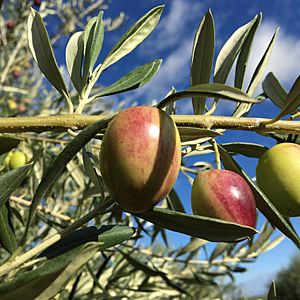Ascolano (olive) facts for kids
Quick facts for kids Ascolano |
|
|---|---|

Ascolano olives
|
|
| Olive (Olea europaea) | |
| Origin | Italy, California |
| Notable regions | Marche, Tuscany |
| Hazards | Verticillium dahliae, Spilocaea oleaginea (peacock or Pan Eye Disease), concerns over spreading X. f. pauca |
| Use | Table |
| Oil content | Low |
| Growth form | Spreading |
| Leaf | Elliptic |
| Weight | Large |
| Shape | Ovoid |
| Symmetry | Asymmetrical |
Ascolano is a special type of olive tree. It's known for being tough against cold weather. This olive is mostly used as a "table olive," meaning it's great for eating! It comes from the Marche and Tuscany areas in Italy. You can also find Ascolano olives growing in California, where they are sometimes used to make olive oil.
Contents
What Makes Ascolano Special?
When Ascolano olives are picked very ripe and then pressed into oil, the oil tastes fruity. Some people say it reminds them of tropical fruits or peaches.
How Ascolano Olives Grow
For Ascolano olive trees to produce fruit, they need help from other olive varieties. This process is called cross-pollination. Other types like Leccino or Pendolino olives help Ascolano trees grow their fruit.
The leaves of the Ascolano tree are wide and shaped like an oval spear. They are about a medium length. The olives themselves are oval-shaped and long. They have a rounded top and a flat bottom.
Keeping Ascolano Olives Healthy
Ascolano olive trees are strong and can handle cold weather well. They are also good at resisting some common plant problems. These include "Peacock Spot," which is caused by a fungus, and "Olive Knot," caused by bacteria.
Protecting Against Diseases
Even though Ascolano olives are tough, farmers still take steps to protect them. They use special sprays, often made with copper, to prevent these diseases. These sprays can include things like copper hydroxide or copper sulfate.
There's also a serious plant disease called Xylella fastidiosa pauca. This disease causes "Olive Quick Decline Syndrome" (OQDS). It has affected many olive trees in Italy, especially in the Apulia region. Even with efforts to stop it, the disease is feared to be spreading. It has been found in several regions of Italy, including Apulia, Calabria, and Tuscany.

